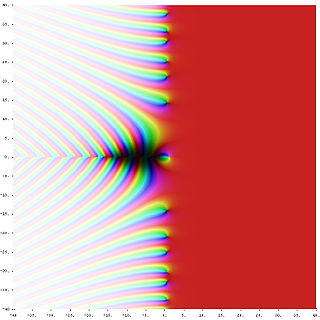In number theory, the prime number theorem (PNT) describes the asymptotic distribution of the prime numbers among the positive integers. It formalizes the intuitive idea that primes become less common as they become larger by precisely quantifying the rate at which this occurs. The theorem was proved independently by Jacques Hadamard and Charles Jean de la Vallée Poussin in 1896 using ideas introduced by Bernhard Riemann.
The Liouville function, denoted by λ(n) and named after Joseph Liouville, is an important function in number theory.
The Riemann hypothesis is one of the most important conjectures in mathematics. It is a statement about the zeros of the Riemann zeta function. Various geometrical and arithmetical objects can be described by so-called global L-functions, which are formally similar to the Riemann zeta-function. One can then ask the same question about the zeros of these L-functions, yielding various generalizations of the Riemann hypothesis. Many mathematicians believe these generalizations of the Riemann hypothesis to be true. The only cases of these conjectures which have been proven occur in the algebraic function field case.

In mathematics, analytic number theory is a branch of number theory that uses methods from mathematical analysis to solve problems about the integers. It is often said to have begun with Peter Gustav Lejeune Dirichlet's 1837 introduction of Dirichlet L-functions to give the first proof of Dirichlet's theorem on arithmetic progressions. It is well known for its results on prime numbers and additive number theory.

In mathematics, the integral test for convergence is a method used to test infinite series of non-negative terms for convergence. It was developed by Colin Maclaurin and Augustin-Louis Cauchy and is sometimes known as the Maclaurin–Cauchy test.
In mathematics, the L-functions of number theory are expected to have several characteristic properties, one of which is that they satisfy certain functional equations. There is an elaborate theory of what these equations should be, much of which is still conjectural.
In mathematics, the Hilbert–Pólya conjecture is a possible approach to the Riemann hypothesis, by means of spectral theory.

In mathematics, the Z-function is a function used for studying the Riemann zeta-function along the critical line where the argument is one-half. It is also called the Riemann–Siegel Z-function, the Riemann–Siegel zeta-function, the Hardy function, the Hardy Z-function and the Hardy zeta-function. It can be defined in terms of the Riemann–Siegel theta-function and the Riemann zeta-function by
In mathematics, the Lindelöf hypothesis is a conjecture by Finnish mathematician Ernst Leonard Lindelöf about the rate of growth of the Riemann zeta function on the critical line. This hypothesis is implied by the Riemann hypothesis. It says that, for any ε > 0,

In mathematics, the universality of zeta-functions is the remarkable ability of the Riemann zeta-function and other, similar, functions, such as the Dirichlet L-functions, to approximate arbitrary non-vanishing holomorphic functions arbitrarily well.
In mathematics, the Selberg class is an axiomatic definition of a class of L-functions. The members of the class are Dirichlet series which obey four axioms that seem to capture the essential properties satisfied by most functions that are commonly called L-functions or zeta functions. Although the exact nature of the class is conjectural, the hope is that the definition of the class will lead to a classification of its contents and an elucidation of its properties, including insight into their relationship to automorphic forms and the Riemann hypothesis. The class was defined by Atle Selberg in, who preferred not to use the word "axiom" that later authors have employed.
This article gives some specific values of the Riemann zeta function, including values at integer arguments, and some series involving them.
In mathematics, a Kloosterman sum is a particular kind of exponential sum. They are named for the Dutch mathematician Hendrik Kloosterman, who introduced them in 1926 when he adapted the Hardy–Littlewood circle method to tackle a problem involving positive definite diagonal quadratic forms in four as opposed to five or more variables, which he had dealt with in his dissertation in 1924.
The Selberg zeta-function was introduced by Atle Selberg (1956). It is analogous to the famous Riemann zeta function

In mathematics, the Chebyshev function is either of two related functions. The first Chebyshev functionϑ(x) or θ(x) is given by
The Sokhotski–Plemelj theorem is a theorem in complex analysis, which helps in evaluating certain integrals. The real-line version of it is often used in physics, although rarely referred to by name. The theorem is named after Julian Sochocki, who proved it in 1868, and Josip Plemelj, who rediscovered it as a main ingredient of his solution of the Riemann-Hilbert problem in 1908.
In mathematics, the ATS theorem is the theorem on the approximation of a trigonometric sum by a shorter one. The application of the ATS theorem in certain problems of mathematical and theoretical physics can be very helpful.




















